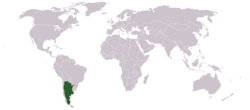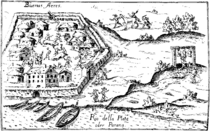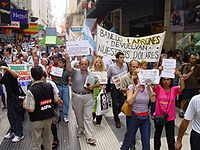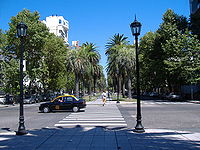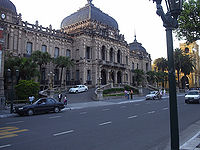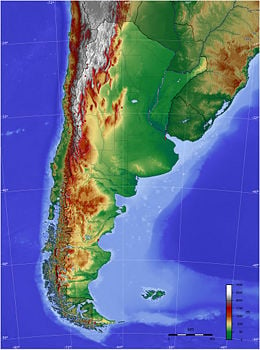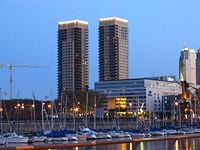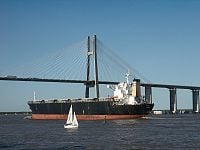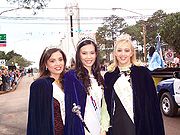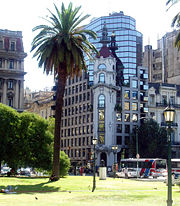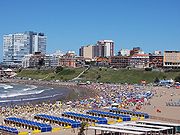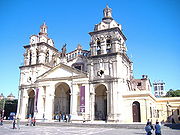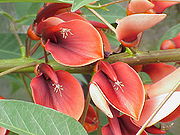Argentina
| República Argentina Argentine Republic |
||||||
|---|---|---|---|---|---|---|
|
||||||
| Motto: Spanish: En Unión y Libertad (English: "In Union and Liberty") |
||||||
| Anthem: Himno Nacional Argentino |
||||||
| Capital (and largest city) | Buenos Aires 34°20′S 58°30′W | |||||
| Official languages | Spanish | |||||
| Government | Federal republic | |||||
| - | President | Néstor Kirchner | ||||
| Independence | From Spain | |||||
| - | May Revolution | 25 May 1810 | ||||
| - | Declared | 9 July 1816 | ||||
| - | Recognized | 1821 (by Portugal) | ||||
| Area | ||||||
| - | Total | 2,780,400¤ km² (8th) 1,073,514¤ sq mi |
||||
| - | Water (%) | 1.1 | ||||
| Population | ||||||
| - | 2005 estimate | 38,747,000 (30th) | ||||
| - | 2001 census | 36,260,130 | ||||
| GDP (PPP) | 2005 estimate | |||||
| - | Total | US $533.722 billion (22nd) | ||||
| - | Per capita | US $14,109 (50th) | ||||
| Currency | Peso (ARS) |
|||||
| Time zone | ART (UTC-3) | |||||
| - | Summer (DST) | ARST (UTC-3) | ||||
| Internet TLD | .ar | |||||
| Calling code | +54 | |||||
| ¤ Argentina also has a territorial dispute with the United Kingdom over an additional 1,000,000 km² of Antarctica, the Falkland Islands and South Georgia and the South Sandwich Islands, for a total of 3,761,274 km² (1,452,236 sq mi). | ||||||
Argentina is the second-largest country in South America and the eighth-largest country in the world.
It occupies a continental surface area of 2,791,810 km² (1,078,000 sq mi) and is located between the Andes mountain range in the west and the southern Atlantic Ocean in the east and south. It is bordered by Paraguay and Bolivia in the north, Brazil and Uruguay in the northeast, and Chile in the west and south. It also claims the British overseas territories of the Falkland Islands (Spanish: Islas Malvinas) and South Georgia and the South Sandwich Islands. Under the name of Argentine Antarctica, it claims 969,464 km² (374,312 sq mi) of Antarctica, overlapping other claims by Chile and the United Kingdom.
The country is formally named the Argentine Republic (Spanish: República Argentina, IPA [reˈpuβlika aɾxenˈtina]), but for purposes of legislation, the form Nación Argentina (Argentine Nation) is used.
Origin and history of the name
- See also: List of meanings of countries' names
The name Argentina derives from the Latin argentum (silver). The first Spanish conquistadors discovered the Río de la Plata ("River of Silver" or "River Plate"). Indigenous people gave gifts of silver to the survivors of the shipwrecked expedition, who were led by Juan Díaz de Solís. The legend of Sierra del Plata — a mountain range of silver — reached Spain around 1524. The source of the silver was the area where the city of Potosí, in current day Bolivia, was to be founded in 1546. An expedition that followed the trail of silver up the Paraná and Pilcomayo rivers finally reached the source of the silver, only to find it already claimed by previous explorers that had reached it from Lima, the capital of the Viceroyalty of Peru.
The name Argentina was first used in Ruy Díaz de Guzmán's 1612 book Historia del descubrimiento, población, y conquista del Río de la Plata (History of the discovery, population, and conquest of the Río de la Plata), naming the territory Tierra Argentina (Land of Silver).[1] [2]
History
The first signs of human presence in Argentina are located in Patagonia (Piedra Museo, Santa Cruz), and date from 11,000 B.C.E. [3]. Around 1 C.E., several corn-based civilizations developed in the western and northwestern Andean region (Ansilta, Condorhuasi, Ciénaga, Aguada, Santa María, Huarpes, Diaguitas, Sanavirones, among others). In 1480 the Inca Empire, under the rule of emperor Pachacutec, launched an offensive and conquered present-day northwestern Argentina, integrating it into a region called Collasuyu. In the northeastern area, the Guaraní developed a culture based on yuca and sweet potato. The central and southern areas (Pampas and Patagonia) were dominated by nomadic cultures, unified in the 17th century by the Mapuches, and never conquered by the Europeans.
The first Europeans arrived in 1502. Spain established a permanent colony on the site of present-day Buenos Aires in 1580, and the Viceroyalty of the Río de la Plata in 1776. In 1806 and 1807 the British Empire invaded the Viceroyalty, but the creole population managed to repel the invasions. On May 25, 1810, after the confirmation of rumors about the overthrow of King Ferdinand VII by Napoleon, the most prominent citizens of Buenos Aires took advantage of the situation and created the First Government Junta. Independence from Spain was declared on July 9, 1816. As in other South American countries, Argentina faced the a conflict between centralist and federalist forms of government. Centralist and federationist groups (Spanish: Unitarios and Federales) were in conflict until national unity was established and the constitution promulgated in 1853.
Foreign investment and immigration from Europe led to the adoption of modern agricultural techniques and integration of Argentina into the world economy in the late 19th century. In the 1880s, the "Conquest of the Desert" subdued or exterminated the remaining indigenous tribes throughout Patagonia.
From 1880 to 1930, Argentina enjoyed increasing prosperity and prominence. Conservative forces dominated Argentine politics until 1916, when their traditional rivals, the Radicals, won control of the government. The military forced Hipólito Yrigoyen from power in 1930, leading to another decade of conservative rule.
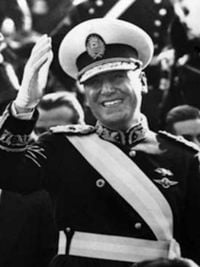
Political change led to the presidency of Juan Perón in 1946, who tried to empower the working class and greatly expanded the number of unionized workers. The Revolución Libertadora of 1955 deposed him.
From the 1950s to 1970s, military and civilian administrations traded power. In those years the economy grew strongly and poverty declined (less than 6% in 1975) while political violence continued escalating. In 1973, Perón returned to the presidency, but he died less than a year after. His third wife Isabel, the Vice President, succeeded him in office, but a military coup removed her from office on 24 March, 1976.
The armed forces took power through a junta in charge of the self-appointed National Reorganization Process until 1983. The armed forces repressed opposition using harsh illegal measures (the "Dirty War"); thousands of dissidents "disappeared", while the SIDE cooperated with DINA and other South American intelligence agencies, and allegedly with the CIA in Operation Condor. Many of the military leaders that took part in the Dirty War were trained in the U.S.-financed School of the Americas, among them Argentine dictators Leopoldo Galtieri and Roberto Viola.
Economic problems, charges of corruption, public revulsion in the face of human rights abuses and, finally, the country's 1982 defeat by the British in the Falklands War discredited the Argentine military regime.
Democracy was restored in 1983. Raúl Alfonsín's Radical government took steps to account for the "disappeared", established civilian control of the armed forces, and consolidated democratic institutions. The members of the three military juntas were prosecuted and sentenced to life terms. Failure to resolve endemic economic problems and an inability to maintain public confidence led to Alfonsín's early departure.
President Carlos Menem imposed a peso-dollar fixed exchange rate in 1991 to stop hyperinflation and adopted far-reaching market-based policies, dismantling protectionist barriers and business regulations, and implementing a privatization program. These reforms contributed to significant increases in investment and growth with stable prices through most of the 1990s.
The Menem and de la Rúa administrations faced diminished competitiveness of exports, massive imports which damaged national industry and reduced employment, chronic fiscal and trade deficits, and the contagion of several economic crises. The Asian financial crisis in 1998 precipitated an outflow of capital that mushroomed into a recession, which led to a total freezing of bank accounts (the corralito), and culminated in a financial panic in November 2001. The next month, amidst bloody riots, President de la Rúa resigned.
In two weeks, several new presidents followed in quick succession, culminating in Eduardo Duhalde being appointed interim President of Argentina by the Legislative Assembly on 2 January 2002. Argentina defaulted on its international debt obligations. The peso's almost 11-year-old linkage to the U.S. dollar was abandoned, resulting in major depreciation of the peso and inflation, in turn triggering a jump in unemployment and poverty. Although it was one of Argentina's worst crises ever, a military coup did not materialize and democracy remained in place.
With a more competitive and flexible exchange rate, the country started implementing new policies based on re-industrialization, import substitution, increased exports, and consistent fiscal surplus. By the end of 2002, the economy began to become stabilized. In 2003, Néstor Kirchner was elected president. During Kirchner's presidency, Argentina restructured its defaulted debt with a steep discount (about 70 percent) on most bonds, renegotiated contracts with utilities, and nationalized previously privatized industries. [4]
Politics
Argentina's political framework is a federal presidential representative democratic republic, in which the President of Argentina is both head of state and head of government, complemented by a pluriform multi-party system. The Argentine Constitution of 1853 mandates a separation of powers into executive, legislative, and judicial branches at the national and provincial level.
Executive power resides in the President and his cabinet. The President and Vice President are directly elected to 4-year terms, limited to two consecutive terms, and the cabinet ministers are appointed by the president.
Legislative power is vested in the bicameral National Congress or Congreso de la Nación, consisting of a Senate (Senado) of 72 seats, and a Chamber of Deputies (Cámara de Diputados) of 257 members. Senators serve 6-year terms, with one-third standing for reelection every 2 years. Members of the Chamber of Deputies are directly elected to 4-year term via a system of proportional representation, with half of the members of the lower house being elected every 2 years. A third of the candidates presented by the parties must be women.
The judiciary is independent of the executive and the legislature. The Argentine Supreme Court of Justice has 9 members who are appointed by the President in consultation with the Senate. The rest of the judges are appointed by the Council of Magistrates of the Nation, a secretariat composed of representatives of judges, lawyers, the Congress, and the executive. (see also law of Argentina)
Argentina also belongs to Mercosur, an international bloc which has some legislative supranational functions. Mercosur is composed of five full members: Argentina, Brazil, Paraguay, Uruguay, and Venezuela. Mercosur also has five associate members without full voting rights: Bolivia, Chile, Colombia, Ecuador, and Peru.
Foreign relations
Argentina was the only Latin American country to participate in the 1991 Gulf War under mandate of the United Nations and in every phase of the Haiti operation. It has also contributed worldwide in peacekeeping operations, including in El Salvador-Honduras-Nicaragua, Guatemala, Ecuador-Peru, Western Sahara, Angola, Kuwait, Cyprus, Croatia, Kosovo, Bosnia and East Timor. In recognition of its contributions to international security and peacekeeping, U.S. President Bill Clinton designated Argentina as a major non-NATO ally in January 1998. In 2005, it was elected as a temporary member of the UN Security Council.
As of 2006, Argentina is currently emphasizing Mercosur as its first external priority, in contrast with its reliance during the 1990s on the relationship with the United States.
In 2005, on November 4 and November 5, the Argentine city of Mar del Plata hosted the Fourth Summit of the Americas. This summit was marked by a number of anti-USA protests.
Argentina claims the sovereignty of the Falkland/Malvinas Islands, the South Shetland Islands, the South Sandwich Islands and almost 1 million km² in Antarctica, between the 25°W and the 74°W meridians and the 60°S parallel. This antarctic sector is called Argentine Antarctica and is considered as part of the national territory, for many reasons, among which is more than one century of permanent occupation.
Administrative divisions
Argentina is divided into 23 provinces (provincias; singular: provincia), and 1 autonomous city (commonly known as capital federal), marked with an asterisk:
|
|
* The current official name for the federal district is Ciudad Autónoma de Buenos Aires.
Buenos Aires has been the capital of Argentina since its unification, but there have been projects to move the administrative centre elsewhere. During the presidency of Raúl Alfonsín a law was passed ordering the transfer of the federal capital to Viedma, a city in the Patagonic province of Río Negro. Studies were underway when hyperinflation, in 1989, killed off the project. Though the law was never formally repealed, it has become a mere historical relic, and the project has been forgotten.
Urbanization
About 2.7 million people live in the autonomous city of Buenos Aires, and roughly 11.5 million in Greater Buenos Aires (2001), making it one of the largest urban conglomerates in the world. Together with their respective metropolitan areas, the second- and third-largest cities in Argentina, Córdoba and Rosario, comprise about 1.3 and 1.1 million inhabitants, respectively.
Most European immigrants to Argentina (coming in great waves especially around World War I and II) settled in the cities, which offered jobs, education, and other opportunities that enabled newcomers to enter the middle class. Since the 1930s, many rural workers have moved to the big cities.
The 1990s saw many rural towns become ghost towns when train services were abandoned and local products manufactured on a small scale were replaced by massive amounts of cheap imported goods, in part because of the monetary policy which kept the U.S. dollar exchange rate fixed and low. Many slums (villas miseria) sprouted in the outskirts of the largest cities, inhabited by empoverished low-class urban dwellers, migrants from smaller towns in the interior of the country, and also a great number of immigrants from neighbouring countries that came during the time of the convertibility and did not leave after the 2001 crisis.
Argentina's urban areas have a European look, reflecting the influence of their European settlers. Many towns and cities are built like Spanish cities around a main square called a plaza. A cathedral and important government buildings often face the plaza. The general layout of the cities is called a damero, or checkerboard, since it is based on a pattern of square blocks, though modern developments sometimes depart from it (for example, the city of La Plata, built at the end of the 19th century, is organized as a checkerboard plus diagonal avenues at fixed intervals).
In descending order by number of inhabitants, the major cities in Argentina are Buenos Aires, Córdoba, Rosario, Mendoza, Resistencia, La Plata, Tucumán, Mar del Plata, Salta, Santa Fe, and Bahía Blanca.
Geography
Argentina is nearly 3,700 km long from north to south, and 1,400 km from east to west (maximum values). It can roughly be divided into three parts: the fertile plains of the Pampas in the central part of the country, the centre of Argentina's agricultural wealth; the flat to rolling plateau of Patagonia in the southern half down to Tierra del Fuego; and the rugged Andes mountain range along the western border with Chile, with the highest point located in the province of Mendoza. Cerro Aconcagua, at 6,960 metres (22,834 ft), is the Americas' highest mountain.
The plains west and south from Buenos Aires are among the most fertile in the world. The western part of La Pampa province and the province San Luis also have plains, but they are drier. The Gran Chaco region in the north of the country is semi-arid.
The steppes of Patagonia, in the provinces of Neuquen, Rio Negro, Chubut and Santa Cruz, are of Tertiary origin. The first human settlement in this area dates back to the 10th century. The first European to reach this zone was Ferdinand Magellan and the first to traverse the Patagonian plain was Rodrigo de la Isla.
Major rivers include the Paraguay, Bermejo, Colorado, Uruguay and the largest river, the Paraná. The latter two flow together before meeting the Atlantic Ocean, forming the estuary of the Río de la Plata. The land between these both is called Mesopotamia and that land is shared by the provinces of Misiones, Corrientes and Entre Ríos. The Argentine climate is predominantly temperate with extremes ranging from subtropical in the north to arid and sub-Antarctic in the far south.
The country has a claim over Antarctica, where it has maintaned a constant occupied presence for more than a century.
Enclaves and exclaves
There is one Argentine exclave: the island of Martín García (co-ordinates 34°11′S 58°15′W). It is near the confluence of the Paraná and Uruguay rivers, a mere kilometre (0.62 mi) inside Uruguayan waters, about 3.5 kilometres (2.1 mi) from the Uruguayan coastline, near the small city of Martín Chico (itself about halfway between Nueva Palmira and Colonia del Sacramento).
An agreement reached by Argentina and Uruguay in 1973 reaffirmed Argentine jurisdiction over the island, ending a century-old dispute between the two countries. According to the terms of the agreement, Martín García is to be devoted exclusively to a natural preserve. Its area is about 2 square kilometres (500 acres), and its population is about 200 people.
Economy
Argentina benefits from rich natural resources, a highly literate population, an export-oriented agricultural sector, and a diversified industrial base. The country historically had a large middle class, compared to other Latin American countries, but this segment of the population was decimated by a succession of economic crises. Today, while a significant segment of the population is still financially well-off, they stand in sharp contrast with millions who live in poverty or on the brink of it.
Since the late 1970s, the country piled up public debt and was plagued by bouts of high inflation. In 1991, the government pegged the peso to the U.S. dollar and limited the growth in the monetary base. The government then embarked on a path of trade liberalization, deregulation, and privatization. Inflation dropped and the gross domestic product grew, but external economic shocks and failures of the system diluted its benefits, causing it to crumble in slow motion, from 1995 and up to the collapse in 2001.
By 2002, Argentina had defaulted on its debt, its GDP had shrunk, unemployment was more than 25 percent, and the peso had depreciated 75 percent after being devalued and floated. However, careful spending control and heavy taxes on now-soaring exports gave the state the tools to regain resources and conduct monetary policy.
In 2003, import substitution policies and soaring exports, coupled with a lower inflation and expansive economic measures, triggered a surge in the GDP, which was repeated in 2004, creating jobs and encouraging internal consumption. Capital flight decreased, and foreign investment slowly returned. The influx of foreign currency from exports created such a huge trade surplus that the Central Bank was forced to buy dollars from the market, which it continues to do at the time, to be accumulated as reserves.
The situation in 2005 is much improved, but large numbers of unemployed people still beg for money or food, particularly in the outskirts of Buenos Aires. Some of them are homeless, and at least one small nonprofit humanitarian organization distributes free food to some of them most days of the week.
However, Argentina is still one of the most developed countries in Latin America. It boasts the highest GDP per capita, the highest levels of education measured by university attendance, and a reasonable infrastructure that in many aspects is equal in quality to that found in fully industrialized nations. Telecommunications are particularly strong, with an important penetration of mobile telephony, Internet and wideband services. In 2002, more than 57 percent of the population was below the poverty line, but at the end of 2005, the amount was 33.8 percent. In 2002, unemployment was more than 25 percent, but by December 2005 it was 10.2 percent. GDP per capita has surpassed the previous prerecession peak of 1998. The economy grew 8.9 percent in 2003, 9.0 percent in 2004, and 9.2 percent in 2005; the floor was set at 7 percent for 2006. As of 2006 foreign debt stands at 68 percent of GDP and is slowly decreasing.[5]
Demographics
Unlike most of its neighbouring countries, Argentina's population descends mostly from Europeans. Most of the population is made up of descendants of Spanish, Italian and other European settlers.
After the regimented Spanish colonists, waves of immigrants from European countries arrived in Argentina throughout the late 19th and early 20th centuries. Contributors include France (mostly to Buenos Aires), Scandinavia (especially Sweden), the United Kingdom and Ireland (Buenos Aires and Patagonia), and Eastern European nations such as Poland, Russia, Ukraine, as well as Balkan nations (especially Croatia, Romania and Serbia). The Patagonian Chubut Valley has a significant Welsh-descended population. The majority of Argentina's Jewish community (the largest in Latin America and the fifth-largest in the world) also derives from immigrants of Northern and Eastern European origin—Ashkenazi Jews.
The largest ethnic minority is the mestizo population in the northern provinces. Since population censuses in Argentina do not take into account mixed-race people as non-white, it is difficult to determine their real size. Estimates range from 3% to 15%, the latter figure being the most credited.
Small numbers of people from Far East Asia have also settled Argentina, mainly in Buenos Aires. The first Asian-Argentines were of Japanese descent, but Koreans, Vietnamese, and Chinese soon followed. There are also smaller numbers of people from the Indian subcontinent.
In recent decades, especially during the 1990s, there has been a substantial influx of immigrants from neighboring South American countries, mainly from Paraguay, Bolivia, Peru, and Chile.
Argentina also has a large Arab community, made up of immigrants from Syria and Lebanon.
The officially recognized indigenous population in the country, according to the 2005 Complementary Survey of Indigenous Peoples, stands at aprox.318,700 persons (0.8 percent of the total population), who are either members or first-generation descendants of a recognized indigenous community. These parameters may imply an under-count of the indigenous population, as most indigenous Argentines are no longer tribally affiliated; in some circumstances they have not been for several generations.
Culture
Argentine culture has been primarily informed and influenced by its European roots. Buenos Aires is undeniably the most European city in South America and considered by many its cultural capital, due both to the prevalence of people of European descent and to conscious imitation.
Argentina has a rich history of world-renowned literature, including one of 20th century's most critically acclaimed writers, Jorge Luis Borges.
Argentine cinema has achieved international recognition with films such as The Official Story, Nine Queens or Iluminados por el Fuego, although they only rarely rival Hollywood-type movies in popularity. Even low-budget productions, however, have earned prizes in cinema festivals (such as Cannes). The city of Mar del Plata organizes its own festival dedicated to this art.
Argentine food is influenced by cuisine from Spain, Italy, Germany, France and other European countries. Argentina has a wide variety of staple foods, which include empanadas, a stuffed pastry; locro, a mixture of corn, beans, meat, bacon, onion, and gourd; and chorizo, a meat-based spicy sausage. The Argentine barbecue, asado, is one of the most famous in the world and includes various types of meats, among them chorizo, sweetbread, chitterlings, and blood sausage. A common custom among Argentines is drinking mate.
Football is the most popular sport, although the national sport of the country is pato. Argentina has a number of highly-ranked polo players. [6]
Music
Argentine culture is exemplified by its music and dance, particularly tango. To foreigners, tango refers to a particular dance, but the music together with the lyrics (often sung in a kind of slang called lunfardo) are what most Argentines primarily mean by tango. In modern Argentina, tango music is enjoyed by itself, particularly since the radical Ástor Piazzolla redefined the music of Carlos Gardel.
Since the 1970s, rock and roll has been widely popular in Argentina. Rock and roll and pop music have experienced periodic bursts of popularity, with many new bands (such as Soda Stereo and Sumo) and composers (such as Charly García and Fito Páez) becoming important referents of national culture. Argentine rock is the most listened-to music among youth.
Buenos Aires is considered the techno and electronica capital of Latin America, and hosts a variety of events including local raves, the South American Music Conference, and Creamfields (which has the world record of 65,000 people).
European classical music is well-represented in Argentina. Buenos Aires is home to the world-renowned Colón Theater. Classical musicians, such as Martha Argerich and Daniel Barenboim, and classical composers like Alberto Ginastera have become internationally famous.
Language
The only national official language of Argentina is Spanish, though the Amerindian language Guaraní also holds official status in the province of Corrientes.
Some immigrants and indigenous communities have retained their original languages in specific points of the country. For example, Patagonia has many Welsh-speaking towns, and there are a number of German-speaking cities in Córdoba, Buenos Aires and again in Patagonia. Italian, English and French are widely spoken, and other languages such as Japanese, Chinese, Korean and Russian are easily found in Buenos Aires, where the main immigrant communities are found.
Argentina is the largest Spanish-speaking community in the world that employs voseo (the use of the pronoun vos instead of tú, associated with some alternate verb conjugations). The most prevalent dialect is Rioplatense, with most speakers located in the basin of the Río de la Plata.
A phonetic study conducted by the Laboratory for Sensory Investigations of CONICET and the University of Toronto showed that the accent of the inhabitants of Buenos Aires (known locally as Porteños) is closer to the Neapolitan Italian dialect than any other spoken language, which can be traced to the influx of Italian immigrants to the port city. This immigration had a profound influence on Lunfardo, the slang spoken in Buenos Aires and the Río de la Plata, which has since permeated popular vocabulary in the region.
Religion
Argentina is an overwhelmingly Christian country. The majority of Argentina's population (80 percent) is at least nominally Roman Catholic. Roman Catholicism is supported by the state and endorsed in the Constitution. Evangelical churches have gained a foothold in Argentina since the 1980s, and their followers now number more than 3.5 million or 10 percent of the total population. Members of the Church of Jesus Christ of Latter-day Saints (Mormons) number over 330,300, the seventh-largest concentration in the world[7]. Traditional Protestant communities are also present.
The country also hosts the largest Jewish population in Latin America, about 2 percent of the population.[8] It is also home to one of the largest mosques in Latin America, serving Argentina's small Muslim community.
Public holidays
Argentines commemorate a number of historical events, such as the May Revolution (25 May), Independence Day (9 July), Malvinas Day (2 April) and Memorial Day (24 March, the start of the dictatorship of the Proceso). They also celebrate National Flag Day (20 June) through its creator, Manuel Belgrano, and Teachers' Day (11 September) with an homage to Domingo Faustino Sarmiento. The Liberator José de San Martín is honoured on 17 August. Historical figures like San Martín, Belgrano and Sarmiento are remembered on the anniversary of their death, rather than their birth.
Argentina also celebrates international holidays such as Labor Day and Columbus Day, and several Catholic holidays including Christmas, Immaculate Conception and Easter.
Flora and fauna
More than 10% of the World's species of flora are present in Argentina. Many animals live in the northern forests, including many types of wildcats.
In patagonia the most common trees are: lenga (Nothofagus pumilio), alerce (Fitzroya cupressoides), nothofagus genus , coigüe or coihue (Nothofagus dombeyi), ñire(Nothofagus antartica), canelo (Drimys winteri), and mañiu (Podocarpus nubigenus); common plants are: copihue (Lapageria rosea), maqui (Aristotelia maqui), and colihue (Chuscuea coleou); and the animals are: Puma (Felis concolor patagonica), huemul (Hippocamelus bisulus), pudú (Pudu pudu), [[Wild Boar|wild boar] (Sus scrofa), condor (Vultur gryphus), salmons and trouts [1].
See also
Template:Argentine Wikiportal
- Communications in Argentina
- Education in Argentina
- Elections in Argentina
- Foreign relations of Argentina
- Military of Argentina
- National parks of Argentina
- Sport in Argentina
- Tourism in Argentina
- Transport in Argentina
ReferencesISBN links support NWE through referral fees
- ↑ What's our name? About the origin of "Argentina" (Spanish)
- ↑ My name is Argentina About the origin of "Argentina" (Spanish)
- ↑ Piedra Museo
- ↑ Carlos A.Floria and César A. García Belsunce, 1971. Historia de los Argentinos I and II; ISBN 84-599-5081-6
- ↑ *Who Shot Argentina? The Finger Prints On the Smoking Gun Read ‘I.M.F.', Greg Palast, Guardian (London) Sunday, August 12, 2001,)
- ↑ About the culture
- ↑ Number of Mormons in Argentina
- ↑ Number of Jews in Argentina
- This article contains material from the CIA World Factbook which, as a U.S. government publication, is in the public domain. 2000
- Supreme Court of Justice of Argentina (Spanish)
- Presidency of Argentina (Spanish)
- Ministerio de Relaciones Exteriores, Comercio Internacional y Culto - Official website of the Argentine Ministry of Foreign Relations, International Trade and Worship. (Spanish)
- The Special Relationship between Argentina and Brazil
- Historia de las Relaciones Exteriores Argentinas. History of Argentine foreign relations. (Spanish)
- Information about Argentine provinces (Spanish)
- Provincias Argentinas (Spanish)
External links
Government
- (Spanish) (English) Argentina.gov.ar - Official national portal
- (Spanish) Gobierno Electrónico - Official government website
- (Spanish) Presidencia de la Nación - Official presidential website
- (Spanish) Honorable Senado de la Nación - Official senatorial website
- (Spanish) Honorable Cámara de Diputados de la Nación - Official lower house website
- (Spanish) Secretaría de Turismo de la Nación - Official tourism board website
Directories
- (English) Library of Congress
- (English) Open Directory Project
- (English) Encyclopaedia Britannica - Argentina's Country Page
- (English) CIA World Factbook entry on Argentina
News
- (Spanish) Télam (Official news agency)
- (German) Argentinisches Tageblatt (See article)
- (English) Buenos Aires Herald (See article)
- (Spanish) Clarín (See article)
- (Spanish) Diario de Cuyo (San Juan)
- (Spanish) El Liberal (Santiago del Estero)
- (Spanish) La Capital (See article)
- (Spanish) Diario UNO (Mendoza)
- (Spanish) Diario UNO (Entre Ríos)
- (Spanish) Diario Los Andes (Mendoza)
- (Spanish) El Diario (Paraná)
- (Spanish) El Tribuno (Salta)
- (Spanish) Infobae (Buenos Aires)
- (Spanish) La Voz del Interior (Córdoba)
- (Spanish) La Gaceta (Tucumán)
- (Spanish) La Nación (See article)
- (Spanish) La Razón (Buenos Aires)
- (Spanish) La Nueva Provincia (Bahía Blanca)
- (Spanish) Página/12 (See article)
- (Spanish) La Capital (Mar del Plata)
- (Spanish) La Voz del Pueblo (Tres Arroyos)
(Spanish) La Opinión (Rafaela) (Spanish) Castellanos (Rafaela)
Argentina · Bolivia · Brazil · Chile · Colombia · Ecuador · Guyana · Panama* · Paraguay · Peru · Suriname · Trinidad and Tobago* · Uruguay · Venezuela
Dependencies
Aruba* (Netherlands) ·
Falkland Islands (UK) ·
French Guiana (France) ·
Netherlands Antilles* (Netherlands) ·
South Georgia and the South Sandwich Islands (UK)
* Territories also in or commonly reckoned elsewhere in the Americas (North America).
| UN Security Council Members | |
|---|---|
| Permanent Members | |
| China - France - Russia - United Kingdom - United States | |
| Members 2021-2022 | |
| India - Ireland - Kenya - Mexico - Norway | |
| Members 2022-2023 | |
| Albania - Brazil - Gabon - Ghana - United Arab Emirates | |
Credits
New World Encyclopedia writers and editors rewrote and completed the Wikipedia article in accordance with New World Encyclopedia standards. This article abides by terms of the Creative Commons CC-by-sa 3.0 License (CC-by-sa), which may be used and disseminated with proper attribution. Credit is due under the terms of this license that can reference both the New World Encyclopedia contributors and the selfless volunteer contributors of the Wikimedia Foundation. To cite this article click here for a list of acceptable citing formats.The history of earlier contributions by wikipedians is accessible to researchers here:
The history of this article since it was imported to New World Encyclopedia:
Note: Some restrictions may apply to use of individual images which are separately licensed.


